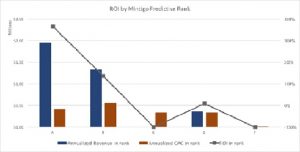Atul Kumar
Chief Product Officer, Mintigo
Modern businesses are increasingly relying on predictive analytics to become more proactive and forward-thinking to meet their goals. Instead of relying on hunches or assumptions, marketers now use the predictive intelligence models to identify the likelihood of future outcomes based on data science and historical data for optimizing marketing campaigns. We spoke to Atul Kumar, Chief Product Officer at Mintigo, to understand how predictive analytics models work.
Html code here! Replace this with any non empty text and that's it.
MTS: Tell us about your role at Mintigo and how you got here?
Atul Kumar: My role at Mintigo is to drive revenue growth for our customers with AI solutions. After spending several years building Martech, I realized that every piece of tech is as good as the data that powers it. We build our own company (SetLogik, acquired by ReachForce) on that premise. However, not having 3rd party data was limiting factor in driving results from predictive analytic applications such as predictive lead scoring. I set out to search for companies that have mastered the art and science of collecting data from the world wide web and translating that into meaningful insights. I researched various companies, and finally my search led to Mintigo. At that time, Mintigo was providing look-alikes using a limited amount of customer data and its own insights gleaned from a vast B2B data set. They had created the most comprehensive B2B data set and an AI engine to find most likely buyers for the B2B sellers and marketers. It is needless to say that tech team and the founders had the tremendous know-how and unique abilities given their background in Israeli Intelligence!
MTS: In your work with predictive analytics, what behavior or outcome do your models predict?
Atul: The way we think about predictive modelling is to ask the question; “what business needs do you want to address with predictive analytics?”. Our AI platform is incredibly flexible and built to answer a variety of business questions. Starting from basic marketing and sales needs such as “we’ve too many leads and we need a better way to prioritize” or “we don’t have enough leads and we need to get more” or “we are starting with ABM and we need to figure out the right accounts” or “we have a new product and we need to start finding right companies and folks for our new product launch” or “ we have hundreds of product, which product(s) will someone buy” to very complex questions such as “we want to use non-financial indicators to predict creditworthiness on the fly for e-commerce”. In short, we offer a very comprehensive AI solution platform that can help with the variety of business needs.
MTS: Enlighten our audience about the sources of data used in predictive analysis.
Atul: When it comes to data, more the merrier should be the mantra. There are four main types of data used in most predictive modeling for B2B; the first type is what commonly referred as ‘Fit’ – these type of signal include but not limited to technology ownership, hiring patterns, business KPIs, data quality validators, among many others; the second group is called the ‘1st party Intent’ – these signals are derived from customer’s own engagement data such as website visitations, responses to marketing offers, sales activities etc.; the third group is called ‘3rd party Intent’ – this is key to determine if some company (and Business Unit) in-market for a given product or service and the last one is customer install base information. These four data types are essential ingredients for robust predictions albeit our experience shows that 1st party intent is not that critical.
MTS: Do marketers still need to have a primary CRM/ DAM/MDM platform in place before investing in predictive analytics?
Atul: It really depends on their business needs. Although I’ve seen great success where customers are using our AI platform without using a CRM, I highly recommend that customers have MAP/CRM solutions in place prior to investing in predictive. DAM/MDM are not critical.
MTS: How do you measure the predictive lift of your model or the ROI of the analytics inventiveness? Will AI bring higher ROI into ABM for MarTech customers?
Atul: This is the million dollar question and one that everyone should be asking the predictive vendors before buying a solution. Predictive analytics, when applied correctly, is delivering tremendous ROI. More than 50% increase in conversion rates (from lead to Close/Won) and more than 40% increase in deal sizes are fairly common among our customers. We calculate ROI by looking at revenue you generate from predictively prioritized leads and accounts and take into consideration of marketing and sales CAC of a deal. As you can see from the figure below, the top-ranked (ranks A & B) accounts and leads generate in excess of 300% ROI while you are losing money on lowest ranked (ranks C, D, F) leads and accounts. The case of predictive has been made for B2C long time ago, now it’s B2B turn to benefit from predictive applications.

MTS: How can marketers leverage predictive analytics to customer experience at scale?
Atul: Great question. Over last two decades, the digital revolution has resulted in many changes; first of all it has put ‘buyers in the driving seat’ – several research articles show that over 50% of a B2B buyer journey is completed before reaching out to vendors; second it created large amount of data which is untapped by conventional CRM/MAP systems. Given the transformation in buyer behavior and the explosion of data, the marketers and sellers have a big challenge and an even a bigger opportunity. Steve Lucas, CEO of Marketo, describes the “engagement economy’ eloquently in his blog post. Enterprises must engage their buyer in a most personalized manner at the right time and the right place. And you must do that at scale. AI and predictive solutions are the only way to engage buyers intelligently at scale. AI and predictive applications for B2B enterprises have an equivalent impact as growth hacking applied by likes of Airbnb, Uber, Netflix etc to boost their market share and revenue.
MTS: According to last year’s report by IBM Analytics, “Predictive analytics users retain 27% more of their customers.” How should CMOs plan their investments into predictive to retain more customers in coming months?
Atul: CMO’s now have the tools, the big data and data scientists at their disposal. CMOs must lay out the bigger vision for AI for the company (across the entire customer journey) and partner with credible vendors to execute. Crawl, walk and run is the right way to plan and execute. However, just like with any new technology purchase, change management is critical. Aligning their peers up and down the c-chain is critical for the success. But then it can be said for any initiative!
MTS: Thanks for chatting with us, Atul.
Stay tuned for more insights on marketing technologies. To participate in our Tech Bytes program, email us at news@martechseries-67ee47.ingress-bonde.easywp.com











